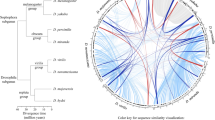Abstract
HETEROCHROMATIN is the highly compact, usually pericentromeric, region of eukaryotic chromosomes. Unlike the more gene-rich euchromatin, heterochromatin remains condensed during interphase, when it is sequestered to the periphery of the nucleus1–3. Here we show, by using fluorescent in situ hybridization to interphase diploid nuclei of Drosophila, that the insertion of heterochromatin into a euchromatic gene, which results in position-effect variegation (PEV), also causes the aberrant association of the gene and its homologous copy with heterochromatin. In correlation with the gene's mutant variegating phenotype, the cytological association of the heterochromatic region is affected by chromosomal distance from heterochromatin and by genie modifiers of PEV. Proteins that are thought to be involved in the formation of heterochromatin can therefore influence the interphase nuclear position of a chromosomal region. This suggests that heterochromatin and proteins involved in its formation provide a structural framework for the interphase nucleus.
This is a preview of subscription content, access via your institution
Access options
Subscribe to this journal
Receive 51 print issues and online access
$199.00 per year
only $3.90 per issue
Buy this article
- Purchase on Springer Link
- Instant access to full article PDF
Prices may be subject to local taxes which are calculated during checkout
Similar content being viewed by others
Author information
Authors and Affiliations
Rights and permissions
About this article
Cite this article
Csink, A., Henikoff, S. Genetic modification of heterochromatic association and nuclear organization in Drosophila. Nature 381, 529–531 (1996). https://doi.org/10.1038/381529a0
Received:
Accepted:
Issue Date:
DOI: https://doi.org/10.1038/381529a0
This article is cited by
-
Chromatin organization changes during the establishment and maintenance of the postmitotic state
Epigenetics & Chromatin (2017)
-
Getting the genome in shape: the formation of loops, domains and compartments
Genome Biology (2015)
-
Gene positioning and genome function
Frontiers in Biology (2014)
-
Histone variants: making structurally and functionally divergent nucleosomes and linkers in chromatin
Frontiers in Biology (2011)
-
Advancing our understanding of functional genome organisation through studies in the fission yeast
Current Genetics (2011)
Comments
By submitting a comment you agree to abide by our Terms and Community Guidelines. If you find something abusive or that does not comply with our terms or guidelines please flag it as inappropriate.



